AVADirect Clevo P170EM Part 2: GTX 680M Grudge Match
by Jarred Walton on October 15, 2012 6:50 PM ESTClevo P170EM GTX 680M Gaming Performance
We don’t have any major qualifications to go over before we hit the GTX 680M benchmarks, but we did end up running our gaming suite multiple times. The initial shipping driver was a 295 Series NVIDIA build, which is now getting somewhat old. We tested our core gaming suite with those drivers before updating to the 306.23 drivers, and then more recently the 306.97 drivers (there was almost no change in performance between the .23 and .96 drivers, if you’re wondering). Unlike AMD’s Hotfix driver, NVIDIA’s 306.xx driver update is more of a mixed bag—a few games improve in performance, but several titles in our test suite actually drop a bit. Of course, the GTX 680M already had a commanding lead, so losing a few FPS isn’t likely to hurt too much. Here’s the list of notebooks we’ve lined up for the graphs this time (and note that all of the laptop names link to the specific reviews):
| Notebook Configuration Overview | ||||
| Laptop | CPU | Graphics | Storage | Battery |
| AlienwareM17x R4 | Intel i7-3720QM | GTX680M/HD4000 | Hybrid (Intel SRT) | 90Wh |
| AlienwareM18x R2 | Intel i7-3820QM | GTX680M-SLI/HD4000 | SSD RAID | 97Wh |
| ASUS G74SX-A2 | Intel i7-2630QM | GTX560M/HD3000 | SSD | 90Wh |
| Clevo P170EM GTX 680M | Intel i7-3720QM | GTX680M/HD4000 | SSD | 77Wh |
| Clevo P170EM HD 7970M | Intel i7-3720QM | HD7970M/HD4000 | SSD | 77Wh |
| iBUYPOWERCZ-17(MSI GT70) | Intel i7-3610QM | GTX675M/HD4000 | SSD | 60Wh |
| Razer Blade 2012 | Intel i7-3632QM | GTX660M/HD4000 | Hybrid (Intel SRT) | 60Wh |
| Samsung Series 7 | Intel i7-3615QM | GT650M/HD4000 | Hybrid (ExpressCache) | 77Wh |
This is a grudge match between AMD and NVIDIA, and now that we’re sporting the same hardware the only thing separating us from the mobile gaming performance crown is a few pages of benchmarks. We’re going to skip straight to the stuff that presumably everyone is here to see: gaming performance. If you want to see how the P170EM GTX 680M stacks up against the HD 7970M in general applications, we reran all of our general application tests and basically came up with a tie, so we’re going to skip those this time around (though they’re available in Mobile Bench).
Mainstream 1600x900 Gaming
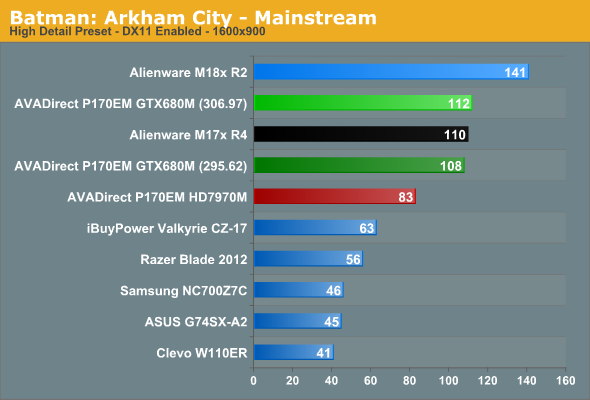
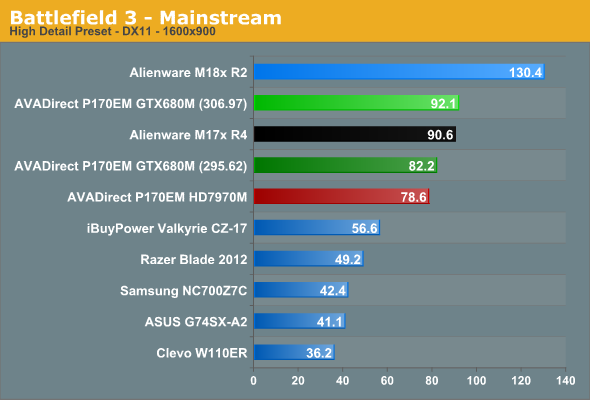
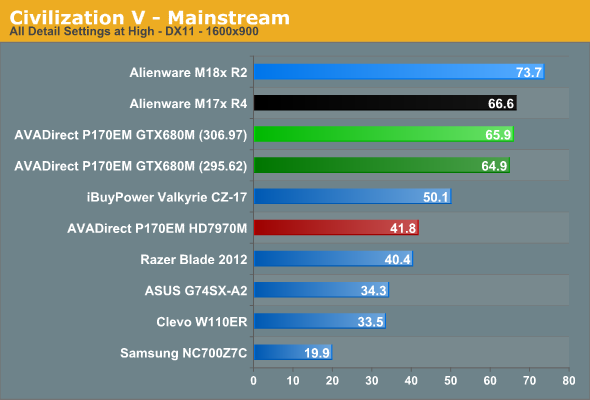
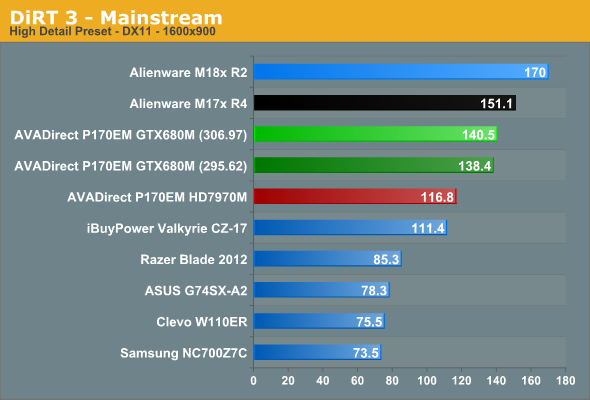

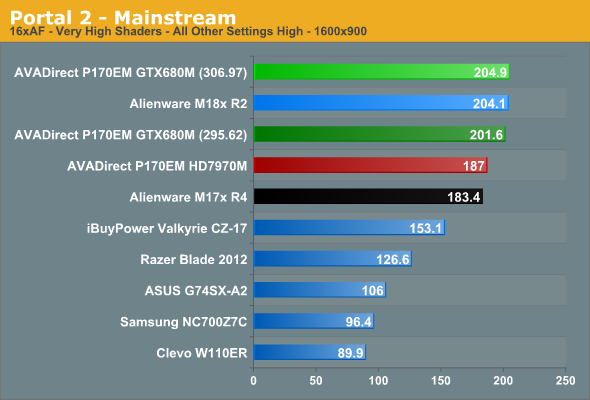
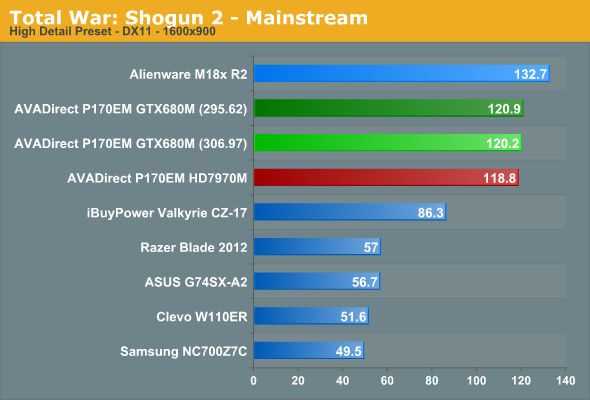
Right out of the gates, NVIDIA’s GTX 680M takes a commanding lead in our Mainstream testing (1600x900 with ~High details). The margin of victory is as much as 58% (Civilization V), though we do have a couple of games that are basically tied (Skyrim goes to the HD 7970M by a couple percent while Shogun 2 favors GTX 680M by just over 1%). With our less demanding settings, NVIDIA leads by an average of 15%—right about what you would want from an 11-15% increase in overall notebook cost. But then, it’s unlikely anyone would plunk down roughly two grand (give or take) just to run at moderately high settings and 1600x900; let’s see what happens when we turn the settings dial to 11.
Enthusiast 1920x1080 Gaming
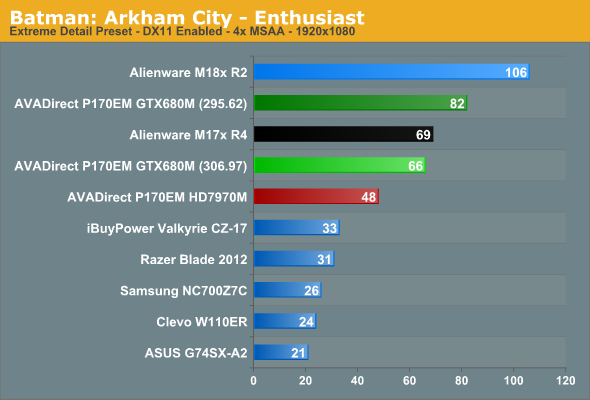
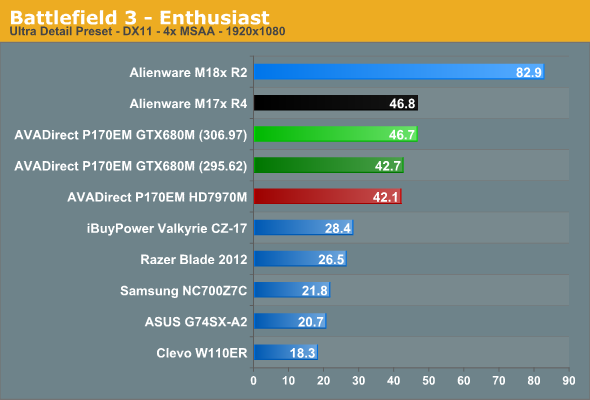
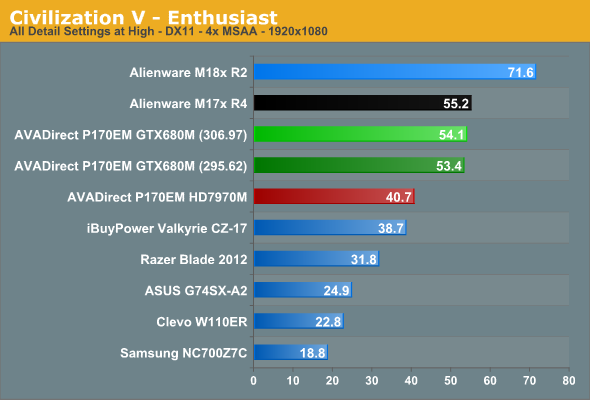
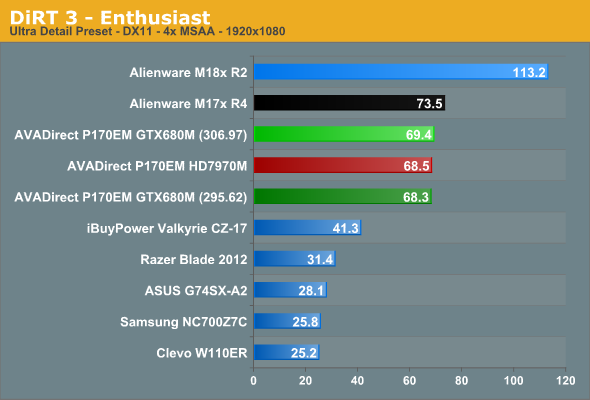
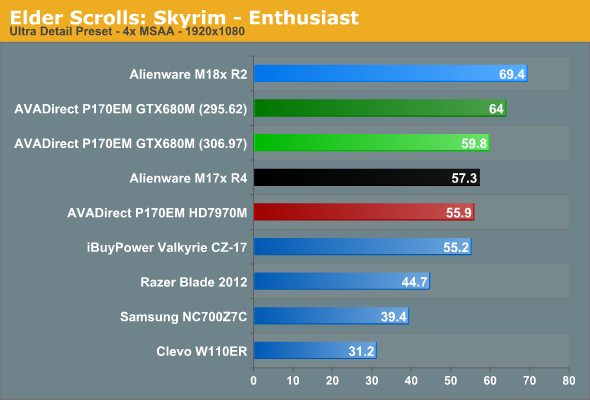
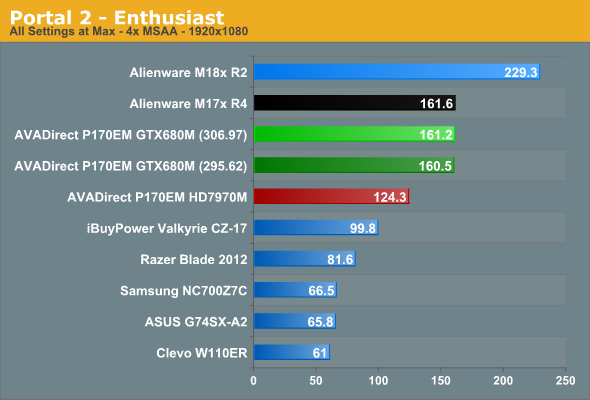

The gap at our Mainstream settings was moderately close, but at Enthusiast detail we end up with several serious blowouts, and unfortunately there’s not a single bright spot for AMD. Batman is a 38% lead for NVIDIA, Civilization V is 33%, and Portal 2 is 30%; those are balanced by a tie in DiRT 3, a scant 7% lead in Skyrim, and an 11% lead in Battlefield 3. Incidentally, Alienware’s M17x R4 shows generally similar performance, with some variations likely caused by differences in the drivers and other components.
As for Shogun 2, unfortunately there’s a driver bug of sorts that prevents us from even testing out the “Very High” preset with AMD’s 7970M—basically, the game looks at the capabilities of the Intel HD 4000 iGPU, which doesn’t allow a few key selections, even though the game is actually supposed to be looking at the HD 7970M. We did run 1080p with identical “nearly max” settings on both GPUs, however, and at least at those settings we wind up with a blowout for NVIDIA: 46.2 FPS compared to 31.3 FPS.
NVIDIA basically takes a clean sweep of our regular gaming benchmarks, but we’re not done with the gaming discussion just yet. We decided to look at some other more recent releases to try to better characterize gaming performance.










58 Comments
View All Comments
JarredWalton - Wednesday, October 17, 2012 - link
It's very simple to say, it's 15-20% faster, my overall experience was better, and if I were in the market for a high-end gaming laptop I would be unhappy with the [current] drivers on the AMD platform, plus the inconsistency of performance.However, if you love Sniper Elite V2 and hate most other games, I sure hope you won't just read that above sentence and assume it's an absolute fact that GTX 680M is better. That's what the rest of the review is for (all 7000 words of it). You're nitpicking over some remarks in the conclusion and suggesting I presented an "inconsistent" piece of information by discussing FPS and performance, when again the conclusion states:
"That’s a cost increase of 15% for a typical gaming performance increase of around 20% at high quality settings (e.g. 1080p 4xAA). Add to that the proven track record of NVIDIA's driver updates and for gaming purposes, that extra $200 is money well spent."
You've got a brain Krumme; use it. If you're in the market for a GPU upgrade to your laptop and you can actually get an MXM 3.0 module with HD 7970M or GTX 680M that will work in your system, obviously you're going to need to look at different pricing that the cost of an entire notebook. My statement comparing total notebook cost with the two GPUs is for 99.9% of people that buy a notebook and don't upgrade it, and I'm not going to try to appease you by dumbing it down. I'm also not going to fall for the marketing gimmick of saying, "NVIDIA is only 20% faster on average but costs 50% more!" That's blatantly false and misleading information for most people shopping for a gaming notebook. Just like I didn't compare a base model Alienware M17x R4 with a GTX 660M, 6GB RAM, 500GB HDD, 1600x900 LCD, etc. to the P170EM reviewed and say, "Wow, Alienware M17x R4 costs $1500 while the P170EM costs $2250!"
krumme - Thursday, October 18, 2012 - link
You are right. I am nitpicking and i am also constantly hysterical critical. Thats why i read Anandtech.And i dont expect you to appeace me, thats also why i read Anandtech. I know my words can be very harsh, sorry for that. I will try to improve it in my next life, as it seems i am to old and sour to change.
And i have the higest regard for the quality of the review, and especially for you beeing involved in the discussion afterwards.
I think its a strawman when you put up the statement "NVIDIA is only 20% faster on average but costs 50% more". Technically its right, and its methology right by comparing single cost to single benefit, but putting it on words is walking all over the fact that the benefit is one of the most important - ift not the most important - benefit of the rig. Then the review would be skewed. We agree.
But you argument is still comparing a - single - benefit, to the - total - cost.
I am not saying you judgement is wrong, probably for most people it is right, but you are not to be the judge. We have plenty of opinion on the net, and thats not why i read Anandtech.
An example following yours. A gamer looking for a Dell machine. He can choose between the 17r with 650 gfx or the Alienware with 660. A lot of gamer would choose the Alienware, not because of the minor difference in speed, but because of the other qualities. Even if there is a huge difference in total cost. Thats because there is way more to a gaming rig for a gamer than FPS. For what and to what degree is a personal preference. The reviewers job is to broaden the view for the reader and put numbers on the consequences.
Your conclusion negates that, directly comparing a single benefit to total cost.
Ofcourse AMD and Nvidia have two different ways they want this presented in the review. Both are wrong.
JarredWalton - Friday, October 19, 2012 - link
So what exactly would you have me say? Just "it's 20% faster than 7970M, which is a decent jump but not earth shattering. Of far more import is the driver situation. Also note that even the fastest mobile GPU right now, the GTX 680M, is basically offering similar performance to a desktop GTX 660. That's a $230 part (albeit with less memory)." That would be true, but I'm not sure it's useful unless you're wondering "should I get a gaming notebook or a gaming desktop?"Notmyusualid - Friday, October 19, 2012 - link
Well, I own dual 7970Ms, and I think Anandtech has spoken; I would have been better spending on the Nvidia solution, as opposed the AMD offering, and I won't whine about it.Not a fan-boi either way, the benchmarks speak for themselves, Nvidia wins.
Mostly mine work, but on some occasions (Shit 2) they are less than perfect.
Thanks for the review, and like the first poster said, if at all possible, could you pit Crossfire against SLI for us?
krumme - Friday, October 19, 2012 - link
You should say exactly nothing in the conclusion, and let your review stand as it is.For one gamer the 20% could be decisive for if he could play his games on the notebook at all (at native resolusion at good quality), or really make a huge difference. And you have given him the numbers.
For another gamer, the extra performance doesnt mean extra user benefits, but he can enjoy all the other qualities of the notebook. And you have given him all the details.
I know its expected in the conclusion there is some sort of judgement, - like its a boxing fight. But instead i would just point out the strong and weak sides for different users on the notebook and the gfx solution.
Regarding the enduro I would lean on the side regarding it as beta not working, and therefore something that as a start should be disabled in the bios. Its simply not a working feature yet. There is a lot of users buying notebooks, also in this class, that is not nerds. Having the feature enabled as a standard is an error in my view.
I dont know if its relevant for the readers to know that they can buy say a 660 on desktop side and get same performance.But i think its a good question. Its about putting the notebook in its context. And againg perhaps some readers dont use all their time comparing between desktop and notebook but buy either notebook or desktop from tradition. They use their time gaming instead of nerding - and they probably as a result use less money on their gear. Unlike us others who try to get as many excuses to create a need, and buy some new expensive gear.
krumme - Friday, October 19, 2012 - link
I know in the conclusion its expected that there is some final judgement like its a boxing match.But I dont expect you to say something, but let the review stand as it is.
For one gamer, the extra fps can be crusial. And you have given him the numbers.
For another, its doesnt give any noticiable difference, but he is more interested in the other qualities. And you have given him the details.
Regarding enduro, its simply not a working feature for other than nerds. And i think it should have been disabled in the bios as a standard, until the drivers are ready.
I think its a good question if its relevant to compare to desktop solutions. Perhaps, as many of your readers use their time gaming, or being in the off topic thread in the forum, instead of nerding, and therefore probably dont use so much time comparing, but buy more or less by habit.
krumme - Friday, October 19, 2012 - link
Man !Disregard the two above
TokamakH3 - Wednesday, October 17, 2012 - link
Only $170 more for the 7970 over the 7870 for a 20-30% speed increase? In a $1700 machine, that's only 10% more! What a huge bargain! 10% more money for a 20-30% performance increase! Why don't you recommend that?Uritziel - Tuesday, October 16, 2012 - link
There is certainly no logical flaw in looking at these two laptop configurations and seeing a ~20% gaming performance increase for a ~15% cost increase. Furthermore, the difficulty (and often infeasibility) of upgrading the gpu in many laptops elevates such reasoning from merely correct to obviously sensible. If this article compared two smartphones with the same numbers, would you make your same trollish complaint?Either way, it's perfectly fine to consider the performance/price ratio from both perspectives. What is NOT fine is your uncalled-for insulting of the author. His reasoning is far from 'idiotic,' and, if such reasoning IS the worst you've seen in the last ~9.5 months, I must conclude you have been cut off from society for almost that same amount of time.
I urge to you to rethink both your position and attitude in the future. Next time you might responding more like this: "Hey Jarred. I notice how you consider the performance/price ratio from a system perspective in the article. I was hoping you might include a line or two appraising it from a component perspective, as I think it would be helpful to let people know that the gpu alone follows the more traditional performance/price curve. Thanks!"
Uritziel - Tuesday, October 16, 2012 - link
"Next time you might responding..." should be "Next time you might try responding..."